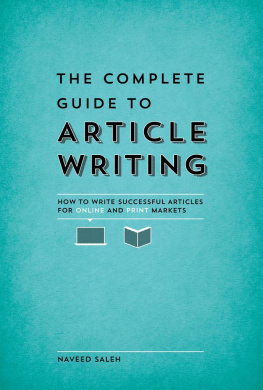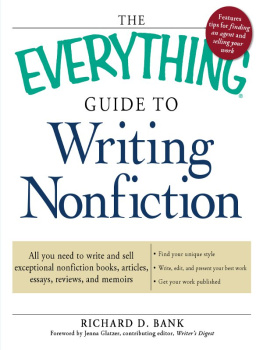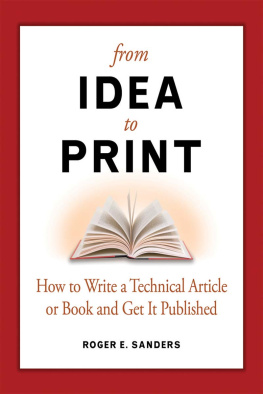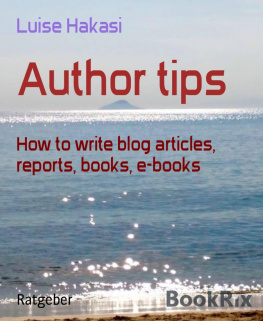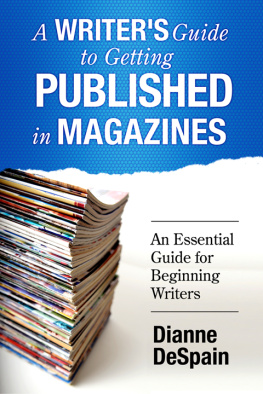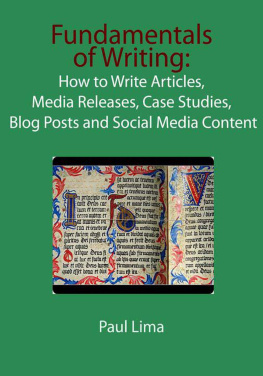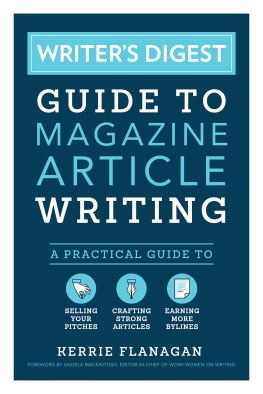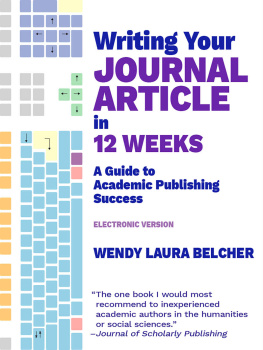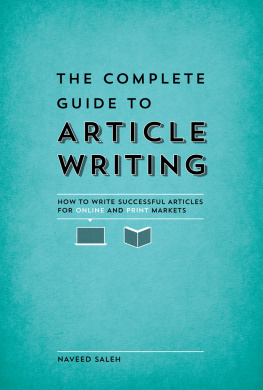THE COMPLETE GUIDE TO
ARTICLE
WRITING
HOW TO WRITE SUCCESSFUL ARTICLES FOR ONLINE AND PRINT MARKETS
NAVEED SALEH

DEDICATION
For DadI miss you.
CONTENTS
FORWORD
See one, do one, teach one. Such was the mantra in medical school. And it is a tradition that Naveed Saleh carries forwardwith substance, style, and much successin The Complete Guide to Article Writing: How to Write Successful Articles for Online and Print Markets.
I have known Naveed since 2008, when he applied to the science journalism graduate program that I coordinate at Texas A&M University. Like me, Naveed is a medical-school graduate whose greatest interests turned out to be writing and editing. The abilities and commitment that Naveed showed in our program have helped enable him to produce a valuable book.
The Complete Guide to Article Writing makes me proud to know Naveed and to have contributed to his education. The book is extensively researched and draws on popular and scholarly literature and on interviews with leaders in academia and the media. It is timeless and also timely, containing both classic advice on writing and current guidance on working in online media. Abundant examples illustrate points. The prose is crisp, readable, witty in places, and sometimes edgy. There is an extensive bibliography. In short, the book not only tells how to write successful articles but also demonstrates the craft.
See one, do one, teach one. In the years since I first met Naveed Saleh, he has seen much good writing in both classes and on his own. He also has done much good writing for magazines and the Web. And now, through the current book, he is teaching others to do so. I enjoyed this book, learned from it, and will recommend it to students. I recommend it to you as well.
Barbara Gastel

INTRODUCTION
Its hard to write a book about article writingand more generally journalismat this juncture in time. You may expect this book to amount to a survey. But how do you survey a field thats in flux? Newspapers are folding, journalists are losing their jobs, and news that once cost money is freely available on the Internet.
Its clear that what worked in the past wont work in the future. Old journalism is not only old but dated, too. In order to survive, the journalist of today must understand and champion new media. The Internet, blogs, social media, and smartphone journalism is the vocabulary of our new Lingua Franca. The journalist of today must be just as concerned with learning style and structure as he is with learning to design websites and build a strong Twitter following. Even if you just want to write articles, you must cultivate various other skills in order to make this dream a reality.
But for those who have the stomach, skills, integrity, and ingenuity, these are wondrous times. The august institutions of yesteryear have been replaced by a frontier mentality typical of the Wild West. Theres a need for entrepreneurs and iconoclasts. Ideas that grab the attention of readers and generate digital-ad revenue will breed success.
With this book, I hope to teach you everything Ive learned about article writing. Of course, Ill teach you about style, structure, interviewing, narrative, ethics, query letters, platforms, and publication. But Ill also help you understand the history of journalism, its status quo, and its possible future. Anybody who masters the concepts in this book will have a strong understanding of the field. I truly believe this understanding will make you a better writer and help you succeed and see your name in a print or virtual byline.
Please dont skim this book; read it in its entirety, and then use it as a reference.
I want you to know that I consider it a privilege to host you with my words. I strived to ensure that the information in this book is attributable to some great mind. Feel free to regale your friends and classmates with knowledge gathered from this book, and know that it has all been verified. I spent years researching this book and months speaking with experts from national consumer magazines, association magazines, newspapers, universities, and more. I drew on dozens of texts, including the works of Jon Franklin, Roy Peter Clark, William Zinsser, and William E. Blundell. I read many journal articles and studies. I even exploited my own understanding of popular culture, finance, psychology, medicine, and science to make the work more entertaining.
I am also privileged to be a custodian of the more general study of journalism. Journalism is an old professioneven older than prostitution. Early prophets believed they were reporting on God.
I think that most people who write books like this one have spent their lives scaling some professional mountain and preach while perched on the summit. The book becomes an extension of some larger ego. I cant pretend to be so weathered. This realization dawned on me early, and I redoubled my efforts to turn out the best product.
I was originally trained as a science (medical) writer, and, at times, this book tends to evaluate and analyze the craft of article writing with an eye toward science and research. Moreover, I believe that every type of writer can benefit from this scientific purview. It should be noted, however, that some fantastic journalism scholars approach the craft of article writing from a humanities or creative-writing perspective. For completeness, I do my best to introduce the reader to some of this thinking.
With respect to word usage, youll see words like writer and journalist or article and story used interchangeably. (If youre reading this book and interested in becoming a writer of articles, feel free to call yourself a journalistas I discuss later, theres no license to practice journalism.) In the realm of journalism, many words lack clear-cut operational or functional definitions. Other words such as source have broad definitions and can refer to people (interviewees) or written sources. Moreover, the word coherent has shades of meaning, too. A coherent explanation can mean a consistent explanation, a clear explanation, or an explanation that offers options. (It can also mean all three.) When writing about the practice of journalism in more theoretical terms, this last meaning is key.
With professional opportunities for budding writers to garner real-world experience dwindling, its important to acclimate readers to variations in newsroom lingo and jargon. Thats why I sometimes refer to documents or ideas in various fashions. For example, although I may write features, features piece, feature article, and so forth, all of these terms refer to one type of story. Developing an ear for the lingo will help anybody, including the freelancer who may never work in a brick-and-mortar setting or the writer of articles who ends up in a newsroom.
Although I do my best to maintain consistency and practice what I preach in terms of style and structure, I acknowledge that this book may suffer occasional lapseseither conscious or unconscious. Please remember that style and structure take a lifetime to learn and are, above all, coherent guides and not dogma. Furthermore, the astute reader will notice that some of my advice on style differs from that of Writers Digest Books, the publisher of this book, including suggestions on number usage and the use of generic singular pronouns. And this is absolutely fine publications and individuals have their own preferences!

